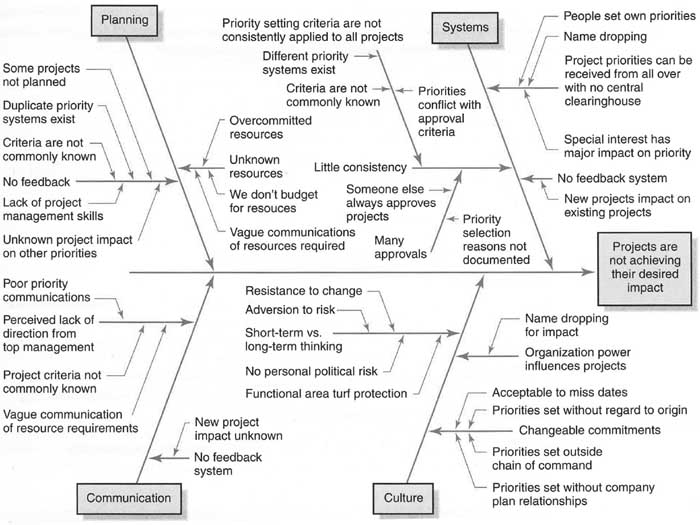The suggestion that a rigorous project priority system be used to select which projects will be budgeted and staffed is frequently met with skepticism and resistance. Typical responses include the following:
- The suggestion that a rigorous project priority system be used to select which projects will be budgeted and staffed is frequently met with skepticism and resistance. Typical responses include the following:
- We already have a priority system. All of our projects are very important.
- Come on. We all know which projects have first priority.
- Our business world changes each day. We don't need a system that locks us out of opportunities. Priorities change.
- Let's not rock the boat. We're getting along. The cream projects always rise to the top.
Resistance responses such as these almost always suggest a deep need for a project priority system. Developing a project priority system will not materialize without top management support and a demonstrated need for all stakeholders. Two approaches used by consultants for establishing a need to change are an interview questionnaire and a survey of current projects. (Note: The same information can be collected and summarized internally.) Individuals or small groups at all levels in the organization are asked to address the general problem of why projects do not achieve their desired impact through the questionnaire. The outcomes can be consolidated into one table and/or a fishbone diagram, which is then communicated to major stakeholders. Typical results of one survey of interviews for projects not achieving the desired impact are summarized in this list:
- No consistent project approval system exists.
- Many individuals can approve projects.
- There is little evidence that project priority is communicated downward.
- Priorities are set outside the chain of command-several priority systems exist.
- Functional areas protect turf.
- Human resources for projects are not budgeted.
- Priorities are set without regard to strategic plan.
- No consistency in applying criteria to projects exists.
- It is not acceptable to refuse project assignments because of lack of resources.
- No feedback system exists for impact of new projects on current projects.
- Pet projects of powerful individuals receive higher priority.
- No central clearing system of projects exists.
- Production is always first.
Sometimes the same information can be more clearly summarized in a fishbone diagram to demonstrate the need for a priority system, as shown in figure below. The fishbone diagram is also an excellent tool for analyzing and isolating symptoms and causes of problems.
An interesting observation is the commonality of answers, regardless of industry or organization size; all groups tend to identify similar problems and even major classifications of problems. The result of the survey is the reinforcement of project problems and an identification of some of the causes-especially the absence of a priority system. The use of the survey questionnaire should have major stakeholders agreeing there is a problem and reaching a consensus that change is needed.
Another factor that can support buy-in of stakeholders to a project priority system is an additional survey of projects in process and proposed projects accepted. Consultants or an internal task force collect a list of all of the projects in process and planned for an organization. The outcome is usually enlightening and startling! The projects easily fall into three categories. Here are the figures for one such inquiry:
- Repetitive operations that are not projects -- e.g., quarterly financial statements (180)
- Projects less than $50,000 or projects less than 500 labor hours (109)
- "Real" projects (72)
Total: 361
These results are typical in product and service organizations. First, many projects are repetitive and represent the basic daily operations of the organization. These recurring activities should be handled and scheduled by the departments responsible and not be treated as projects. Second, projects that require few man-hours or represent a relatively small dollar value do not individually sabotage implementation of high-impact projects. However, such projects in total can have a profound effect on important projects by gobbling up critical resources. Analysis of these small projects regularly points out that they contribute little or nothing to the strategic plan or to meeting the needs of the customer; many could then be eliminated. Finally, the remaining "real" projects are those that clearly contribute significantly to the organization's mission, goals, and strategies. The linkage can be identified. In reality most real projects were selected from a list of proposals without criteria for selection.
The results and implications of this particular inquiry are serious! Planned and proposed real projects typically over commit resources by a factor of four over a five year planning horizon. Some projects need to be eliminated. The total set of real projects lacks focus. This situation suggests the strategic plan had not been communicated effectively to middle management. The hierarchical arrangement of objectives and strategies had not taken place, and the middle managers were not active contributors to the process. No formal system existed for prioritizing projects to optimize their contribution to the strategic plan. The results of using the processes just described are usually earthshaking enough to gain buy-in that some kind of priority system is needed to select and monitor projects. A generic priority system is described in the next section.
PREV: MOVING TO AN EFFECTIVE ORGANIZATIONAL PRIORITY SYSTEMNEXT: A GENERIC SELECTION AND PRIORITY SYSTEM

